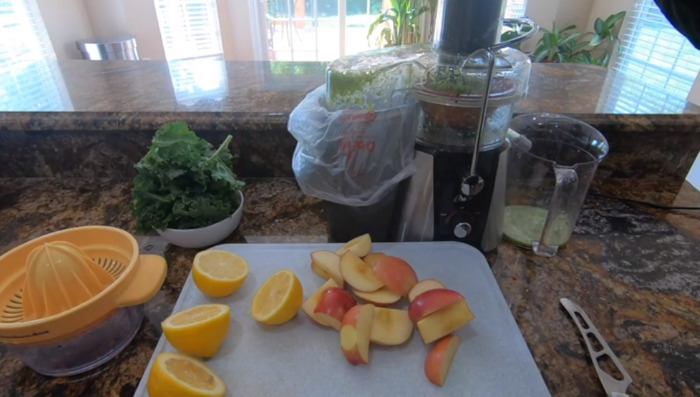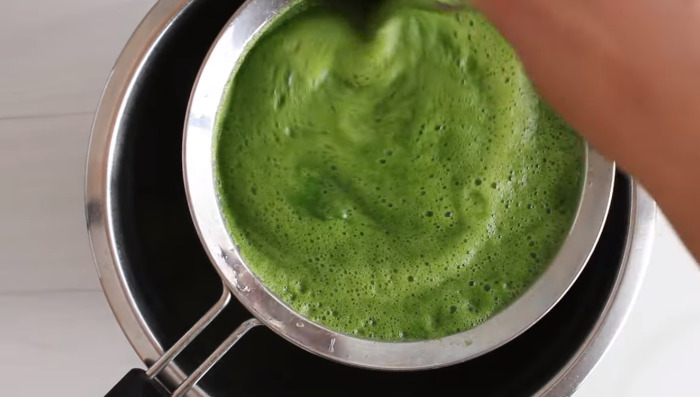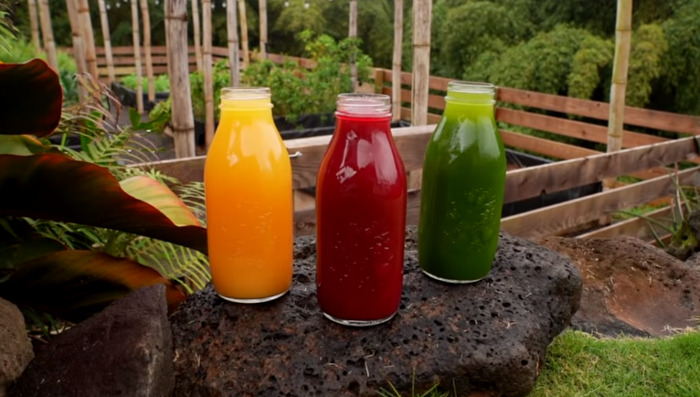Embarking on a journey through the vibrant world of kale tonics, we dive into a realm where health and flavor coalesce into a symphony of well-being. The kale tonic, a lush blend of kale, apple, cucumber, and lemon, isn’t merely a drink; it’s an experience, a gentle caress of nature’s finest, offering not just a burst of refreshing taste but also a myriad of health benefits.
From aiding digestion with its probiotic content to being a beacon of essential nutrients like vitamins and antioxidants, this green elixir stands tall as a testament to nature’s profound ability to nourish and heal. Whether you’re a seasoned juicer or a curious beginner, the kale tonic welcomes all, promising a sip that’s not just nutritiously rich but also a delightful dance of flavors, ensuring that your path to wellness is nothing short of enchanting. Let’s explore, create, and sip, immersing ourselves in a world where every drop is a step towards vitality and wellness.
Recipe to make kale tonic with apple cider vinegar:
Ingredients:
These are the ingredients used for making kale tonic with apple cider vinegar:

- Kale: 2 cups, ensuring a robust, nutrient-dense base, providing essential vitamins and antioxidants.
- Apple: 1 medium-sized (preferably Fuji for a sweet and crisp flavor), contributing natural sweetness and additional dietary fiber.
- Cucumber: 1 whole, peeled and chopped, offering a refreshing and hydrating element to the tonic.
- Lemon: 1 large, peeled, introducing a zesty note that elevates the freshness of the drink.
- Apple Cider Vinegar: 2 tablespoons, infusing the tonic with its characteristic tang and potential digestive benefits.
- Water: 1 cup, to facilitate blending and adjust consistency.
- Ice Cubes: 5 pieces, ensuring your tonic is cool and revitalizing.
- Optional Sweetener: Agave nectar or honey, to taste, if additional sweetness is desired.
Equipment:
Here is the list of equipment used in crafting kale tonic with apple cider vinegar:
- Blender: Essential for combining and smoothly processing the kale, apple, cucumber, and lemon into a lush, unified mixture.

- Juicer (optional): If you prefer a smoother, pulp-free beverage, a juicer can extract the vital essences of your ingredients without the fibrous content.
- Fine Mesh Strainer or Cheesecloth: Handy for separating any remaining pulp or fibers from the juice, ensuring a smoother tonic.
- Measuring Cups and Spoons: To accurately measure ingredients, ensuring the balance and flavor of the tonic are spot-on.
- Cutting Board: A stable surface to safely chop and prepare your fruits and vegetables.
- Sharp Knife: For efficiently and safely chopping your ingredients, ensuring they are easily blendable.
- Glass or Jug: To serve or store your freshly made kale tonic, preserving its vibrancy and freshness.
- Spoon: If you opt to add an optional sweetener, a spoon will be necessary for stirring and integrating it into your tonic.
Instructions:
These straightforward steps guide you through crafting a nutritious and invigorating kale tonic with apple cider vinegar:
1.Prepare Ingredients: Wash and chop the kale, apple, and cucumber into manageable pieces, ensuring they can be easily blended or juiced.
2.Blend or Juice: Utilize your blender or juicer to process the kale, apple, cucumber, and lemon until smooth. If using a blender, aim for a completely liquefied consistency.
3.Strain (if desired): For a smoother tonic, strain the mixture through a fine mesh strainer or cheesecloth to remove any remaining pulp.

4.Add Apple Cider Vinegar: Integrate the apple cider vinegar into the mixture, stirring thoroughly to combine. Ensure the vinegar is well-distributed throughout the tonic.
5.Sweeten to Taste: Optionally, add a sweetener of your choice, adjusting to your palate. Ensure it’s thoroughly dissolved or blended into the tonic.
6.Serve Chilled: For a refreshing experience, chill the tonic in the refrigerator or serve over ice. Ensure it’s cool before enjoying it.
7.Store Properly: If not consuming immediately, store the tonic in a sealed container in the refrigerator to maintain its freshness and vibrancy.
8.Enjoy Regularly: Imbibe your kale tonic with apple cider vinegar as a revitalizing start to your day or a rejuvenating midday pick-me-up.
Health Benefits of Kale Tonic with Apple Cider Vinegar
This kale tonic, enriched with the potent goodness of apple cider vinegar, amalgamates the individual benefits of each ingredient:
- Rich in Nutrients: Kale provides a wealth of vitamins and minerals, supporting overall health and well-being.
- Digestive Aid: Apple cider vinegar and cucumber can facilitate smooth digestion and promote gut health.
- Detoxifying Properties: The ingredients work synergistically to help detoxify the body, aiding in eliminating toxins.
- Weight Management: The acetic acid in apple cider vinegar may enhance metabolism and support weight loss efforts.
- Skin Health: Antioxidants from kale and apples can contribute to a healthy complexion and vibrant skin.

- Immune Boost: The vitamin-rich components support a robust immune system, fortifying against illnesses.
- Heart Health: Ingredients like kale and apple cider vinegar have properties that may promote cardiovascular wellness.
- Anti-Inflammatory: Kale is renowned for its anti-inflammatory properties, potentially reducing inflammation in the body.
- Hydration: Cucumber and apple provide hydration, essential for maintaining bodily functions and skin health.
- Antioxidant-Rich: The tonic is laden with antioxidants, which combat oxidative stress and promote cellular health.
What are the Different Types of Apple Cider Vinegar?
Each type of apple cider vinegar offers its unique characteristics and potential benefits, catering to varied preferences and uses.
- Filtered Apple Cider Vinegar: Clear, with a light amber hue, offering a milder taste and devoid of the “mother.”
- Unfiltered Apple Cider Vinegar: Contains the “mother,” a cloudy, nutrient-rich bacterial culture, and presents a robust flavor.
- Organic Apple Cider Vinegar: Produced without synthetic additives and typically unfiltered, retaining the “mother.”

- Non-Organic Apple Cider Vinegar: May be produced with conventional methods and might contain pesticides.
- Flavored Apple Cider Vinegar: Infused with additional flavors, such as honey or fruits, for a varied taste profile.
- Apple Cider Vinegar Capsules: Available in supplement form, providing an alternative for those who prefer not to consume it as a liquid.
What is the Best Substitute for Apple Cider Vinegar if I Don’t Have It?
Choosing the right substitute for apple cider vinegar hinges on the specific flavor profile and acidity you seek in your dishes.
- White Wine Vinegar: Offers a similar fruity flavor, suitable for dressings and marinades.
- Lemon Juice: Provides acidity and a fresh zest in culinary applications.
- Balsamic Vinegar: Delivers a sweet and slightly tangy flavor, ideal for salads and glazes.
- Red Wine Vinegar: Imparts a robust, zesty taste, apt for marinades and vinaigrettes.
- Rice Vinegar: Milder and sweeter, suitable for Asian dishes and sauces.
- Malt Vinegar: A bold, hearty alternative, great for pickling and fish and chips.
- Distilled White Vinegar: A neutral, sharp option, fitting for cleaning and culinary use.
The Bottom Line:
Navigating through the vibrant world of apple cider vinegar and kale tonic, we’ve embarked on a journey exploring varied facets, from the meticulous selection of ingredients and equipment to the careful adherence to preparation instructions. The versatility of apple cider vinegar, with its rich history and varied types, has been highlighted, offering not only a unique flavor but also a plethora of health benefits. When combined with the nutritious powerhouse that is kale, the resultant tonic becomes a symphony of wellness and flavor. Even in the absence of apple cider vinegar, we’ve seen that alternatives like white wine vinegar or lemon juice can step into the limelight, ensuring our culinary adventures remain unhampered. This exploration into the kale tonic with apple cider vinegar not only enriches our palate but also our understanding, intertwining the threads of healthy living and delightful eating into a tapestry that can be cherished and enjoyed in our daily lives.
FAQs:
Can apple cider vinegar clean out your liver?
Embarking on a daily ritual of sipping kale tonic with apple cider vinegar each morning could potentially usher in a cascade of wellness. The synergy of kale, a nutrient-dense green, and apple cider vinegar, renowned for its varied health benefits like aiding digestion and regulating blood sugar levels, might enhance your overall health. However, it’s pivotal to approach this practice with balance and heed, considering that excessive intake of vinegar can pose challenges to dental health and acid reflux. Always prioritize moderation and consult healthcare professionals to navigate through your health journey wisely.
What happens if I drink kale tonic with apple cider vinegar every morning?
The notion that apple cider vinegar can “clean” the liver circulates widely, yet scientific backing is scant. Apple cider vinegar, lauded for its health benefits, such as aiding digestion and supporting weight loss, is sometimes perceived as a detoxifier. However, it’s crucial to note that the liver is inherently a detoxifying organ, proficiently cleansing the body without necessitating specific foods for optimization. While incorporating apple cider vinegar into your diet might offer various health perks, asserting it cleanses the liver might be an oversimplification without robust scientific substantiation.
Related Read: Healthy Juice Recipes For Weight Loss!







